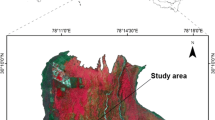Abstract
Forest canopy density is an important parameter to assess the ecological conditionsviz, light penetration through canopy, undergrowth, surface reflectance, rainfall interception, etc. in a forest landscape. The rate of change in the cover and density has increased due to human need for fuel and fodder. Hence, quick, repetitive and accurate information about forest density is required at the local, regional, state and national levels for sustainable forest management. Satellite remote sensing has the potential to provide information on the forest canopy closure. The present study aims at forest canopy density map** using satellite remote sensing data using three techniques: visual interpretation (VI), object oriented image segmentation (OOIS) and biophysical modeling (BM). On comparing the techniques, the BM has been found to be the better density map** technique than other two in terms of accuracy, efficiency and high correlation with ground estimates.
Similar content being viewed by others
References
Anonymous (1993). Rehabilitation of logged over Forests in Asia/Pacific region. Final Report of Sub Project II International Tropical Timber Organization- Japan Oversea Forestry Consultants Association, pp. 1–78.
E-cognition (2001). User guide documentation.
Forest Survey of India (2000). State of Forest Report 1999. Forest Survey of India, New Delhi.
Gaur, R.D. (1989). Dynamics of vegetation of Garhwal Himalayas. In: The vegetational wealth of the Himalayas (Ed.: G.S. Paliwal). Puja Publishers, Delhi.
Houghton, R.A. and Woodwell, G.M. (1981). Biotic contributions to the global carbon cycle: the role of remote sensing. Proc. Seventh International Symposium on Machine Processing of Remote Sensing Data, held at West Lafayette, Indiana, pp. 593–602.
Lillesand, T.M. and Kiefer, R.W. (1994). Remote Sensing and Image Imnterpretation. 3rd edn. John Wiley and Sons, New York, USA.
Malingreau, J.P. (1991). Remote sensing for Tropical Forest Monitoring: an overview. In: Remote Sensing and Geographic Information Systems for Resource Management in Develo** Countries. (Eds.: A.S. Belward and C.R. Valenzuela (Dordrecht: Kluwer), pp. 253–278.
Olson, C.E., Jr. (1960), Elements of photographic interpretation common to several sensors. Photogrammetric Engineering and Remote Sensing,26: 651–656.
Rikimaru, A., Roy, P.S. and Miyatake, S. (2002). Tropical forest cover density map**, Tropical Ecology,43(1): 39–47.
Roy P.S., Diwakar, P.G., Vohra, T.P.S. and Bhan, S.K. (1990). Forest Resource management Using Indian Remote Sensing Satellite data. Asian — Pacific Remote Sensing J.,3: 11–22.
Roy, P.S. (1993) Remote Sensing for Forest Ecosystem Analysis and management. In: Environmental Studies in India (Ed. M. Balakrishnan) Oxford and IBH, New Delhi, pp. 335–363.
Roy, P.S. and Joshi, P.K. (2002). Forest cover assessment in northeast India-the potential of temporal wide swath satellite sensor data (IRS-IC WiFS). Int. Jour. Remote Sensing,23(22): 4881–1896.
Author information
Authors and Affiliations
About this article
Cite this article
Nandy, S., Joshi, P.K. & Das, K.K. Forest canopy density stratification using biophysical modeling. J Indian Soc Remote Sens 31, 291–297 (2003). https://doi.org/10.1007/BF03007349
Received:
Revised:
Issue Date:
DOI: https://doi.org/10.1007/BF03007349




